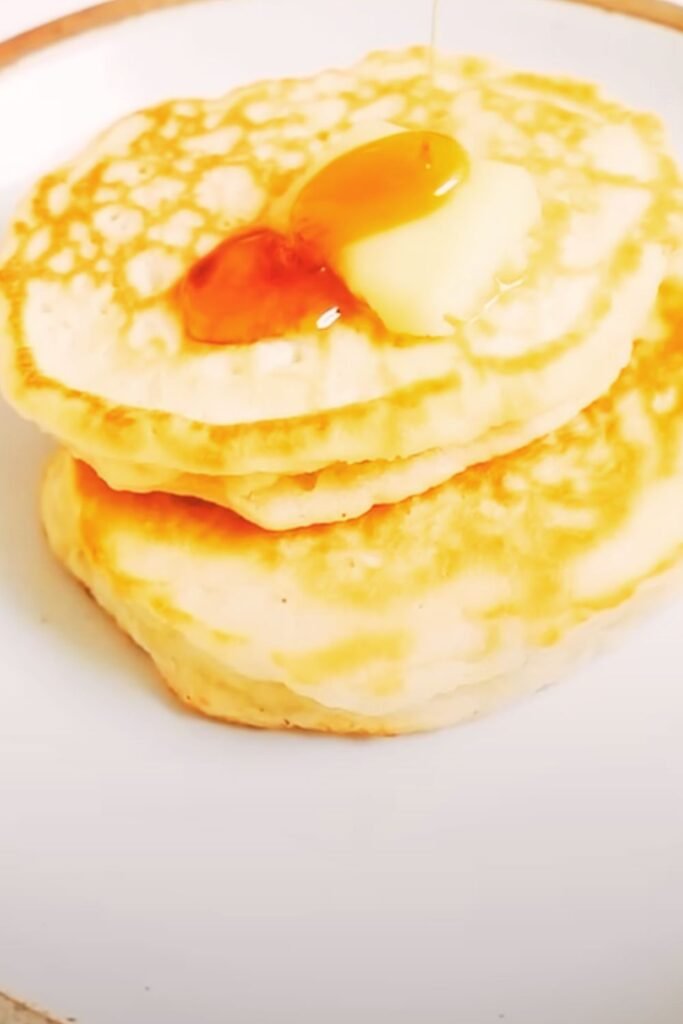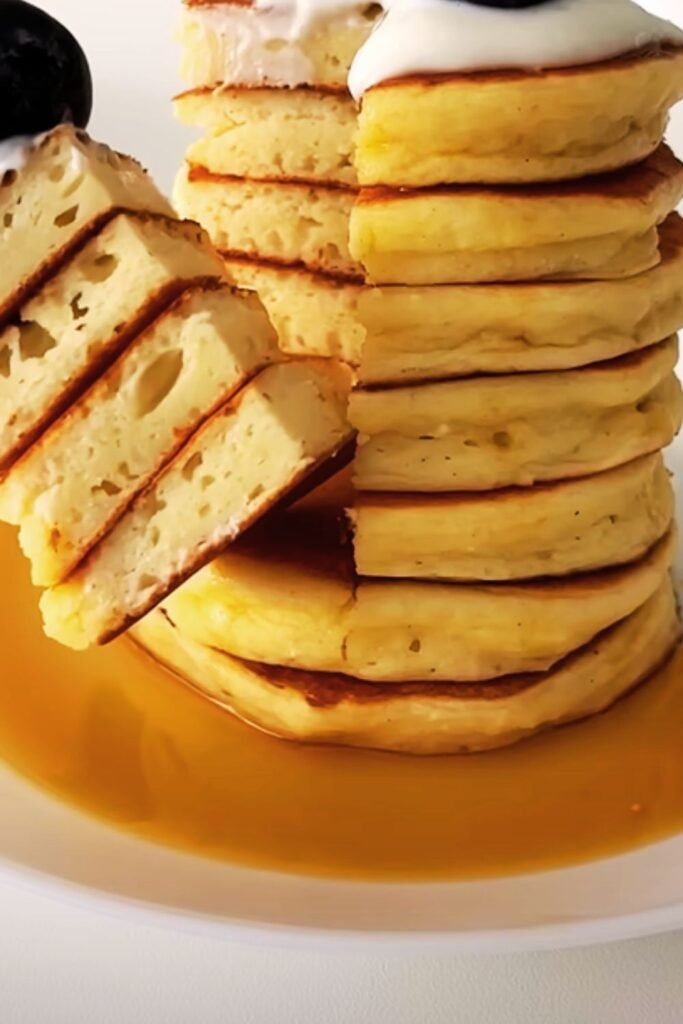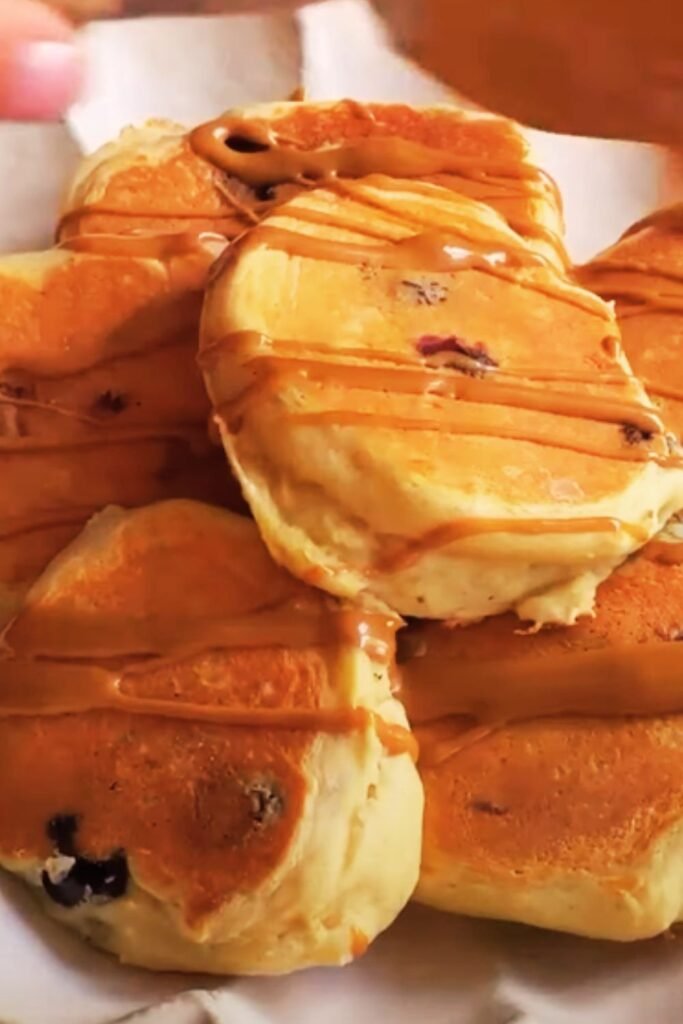I’ve been perfecting my protein pancake recipe for years, and I can confidently say that these fluffy protein pancakes will revolutionize your morning routine. Gone are the days of dense, rubbery protein pancakes that taste more like cardboard than comfort food. My recipe creates genuinely fluffy, delicious pancakes that happen to be packed with protein – not the other way around.
When I first started making protein pancakes, I made every mistake in the book. Too much protein powder, not enough liquid, overmixing the batter – you name it, I did it wrong. But through countless breakfast experiments and more than a few disappointing mornings, I’ve developed a foolproof method that consistently delivers restaurant-quality pancakes right from my own kitchen.
Why Protein Pancakes Are Worth Making
Let me share why I fell in love with protein pancakes in the first place. Traditional pancakes, while absolutely delicious, leave me feeling sluggish and hungry again within an hour. My protein pancakes, on the other hand, keep me satisfied and energized throughout the morning. They’re not just a healthier alternative – they’re genuinely better at doing what breakfast should do.
Protein Benefits:
- Sustained energy release
- Improved muscle recovery
- Better satiety
- Stable blood sugar levels
- Enhanced metabolism
Convenience Factor:
- Quick preparation time
- Freezer-friendly for meal prep
- Customizable flavors
- Kid-approved taste
- Budget-friendly ingredients
Essential Ingredients for Success
I’ve learned that ingredient quality makes or breaks protein pancakes. Here’s my carefully curated list of must-have components:
Protein Powder Selection:
- Whey protein isolate (my top choice)
- Casein protein (for extra fluffiness)
- Plant-based blends
- Egg white protein
- Collagen protein
Flour Components:
- Oat flour (homemade or store-bought)
- Almond flour
- Coconut flour (use sparingly)
- All-purpose flour (for classic texture)
Binding Agents:
- Fresh eggs (room temperature works best)
- Greek yogurt
- Cottage cheese
- Mashed banana
Leavening Agents:
- Baking powder (double-acting)
- Baking soda
- Cream of tartar
My Signature Fluffy Protein Pancake Recipe
After hundreds of attempts, here’s my perfected recipe that never fails:
Ingredients
| Ingredient | Amount | Purpose |
|---|---|---|
| Vanilla whey protein powder | 1 scoop (30g) | Primary protein source |
| Oat flour | 1/2 cup | Structure and texture |
| Large eggs | 2 whole | Binding and fluffiness |
| Greek yogurt (plain) | 1/4 cup | Moisture and tang |
| Unsweetened almond milk | 1/3 cup | Liquid base |
| Baking powder | 1 teaspoon | Leavening |
| Vanilla extract | 1/2 teaspoon | Flavor enhancement |
| Salt | 1/4 teaspoon | Flavor balance |
| Stevia or monk fruit | 1-2 packets | Natural sweetness |
Nutritional Breakdown Per Serving
| Nutrient | Amount | % Daily Value |
|---|---|---|
| Calories | 285 | 14% |
| Protein | 28g | 56% |
| Carbohydrates | 22g | 7% |
| Fat | 8g | 12% |
| Fiber | 4g | 16% |
| Sugar | 6g | – |
| Sodium | 320mg | 14% |
Step-by-Step Preparation Method
I’ve refined my technique over countless mornings, and these steps are crucial for consistent results:
Preparation Phase:
- Allow eggs to reach room temperature (15-20 minutes)
- Preheat griddle to medium-low heat (325°F)
- Gather all ingredients and measuring tools
- Test griddle temperature with water droplet
Mixing Technique:
- Whisk dry ingredients in large bowl
- Combine wet ingredients in separate bowl
- Create well in dry ingredients
- Pour wet into dry ingredients
- Fold gently with rubber spatula (maximum 8-10 folds)
- Let batter rest for 2-3 minutes

Cooking Process:
- Lightly grease griddle with coconut oil
- Pour 1/4 cup batter per pancake
- Cook until bubbles form and edges set (2-3 minutes)
- Flip once and cook additional 1-2 minutes
- Check internal temperature reaches 165°F
Common Mistakes I’ve Made (So You Don’t Have To)
Through my protein pancake journey, I’ve encountered every possible pitfall. Here are the mistakes that taught me the most:
Overmixing Disaster: I used to think more mixing meant better pancakes. Wrong! Overmixing develops gluten, creating tough, chewy pancakes. I learned to fold ingredients just until barely combined, accepting a few lumps for the sake of tenderness.
Temperature Troubles: My early attempts involved cooking on high heat, thinking it would save time. This resulted in burnt exteriors and raw centers. Medium-low heat became my golden rule, allowing even cooking throughout.
Protein Powder Proportions: I once thought more protein meant better pancakes. Too much protein powder creates a chalky, dry texture. The sweet spot is one scoop per batch – enough for benefits without compromising taste.
Liquid Balance Issues: Getting the liquid ratio right took numerous attempts. Too little creates thick, dense pancakes; too much makes them fall apart. I now measure precisely and adjust based on humidity and protein powder brand.
Flavor Variations That Actually Work
After mastering the base recipe, I experimented with countless flavor combinations. Here are my most successful variations:
Chocolate Lovers Delight:
- Add 1 tablespoon unsweetened cocoa powder
- Include 1 tablespoon mini dark chocolate chips
- Use chocolate protein powder
- Top with sugar-free chocolate syrup
Berry Bliss Version:
- Fold in 1/4 cup fresh blueberries
- Add 1/2 teaspoon lemon zest
- Use vanilla or berry protein powder
- Serve with mixed berry compote
Tropical Paradise:
- Include 2 tablespoons shredded coconut
- Add 1/4 cup diced fresh pineapple
- Use coconut flour (reduce to 2 tablespoons)
- Top with toasted coconut flakes
Autumn Spice Blend:
- Mix in 1/2 teaspoon cinnamon
- Add 1/4 teaspoon nutmeg
- Include 1 tablespoon pumpkin puree
- Use vanilla protein powder
- Serve with sugar-free maple syrup
Advanced Techniques for Maximum Fluffiness

Through experimentation, I discovered several techniques that dramatically improve pancake texture:
The Separation Method: I separate eggs, whipping whites to soft peaks before folding into batter. This creates incredibly light, airy pancakes reminiscent of soufflé pancakes.
The Yogurt Trick: Adding Greek yogurt not only increases protein content but also creates tender, moist pancakes. The acidity reacts with baking powder for extra lift.
Temperature Control: I use an infrared thermometer to maintain consistent griddle temperature. This professional approach ensures even cooking and perfect texture every time.
Resting Period: Allowing batter to rest for 2-3 minutes hydrates flour and allows leavening agents to activate fully. This small step makes a noticeable difference in final texture.
Troubleshooting Common Issues
Every home cook encounters challenges, and protein pancakes present unique obstacles. Here’s how I solve the most frequent problems:
Dense, Heavy Pancakes:
- Reduce protein powder by 25%
- Add extra baking powder (1/4 teaspoon)
- Ensure eggs are room temperature
- Don’t overmix batter
Pancakes Falling Apart:
- Add one extra egg
- Include binding agent (xanthan gum)
- Let batter rest longer
- Cook at lower temperature
Bland, Flavorless Results:
- Increase vanilla extract
- Add salt for flavor enhancement
- Include natural sweeteners
- Experiment with extracts and spices
Cooking Unevenly:
- Check griddle temperature consistency
- Use uniform batter portions
- Avoid pressing pancakes while cooking
- Maintain steady heat throughout
Meal Prep and Storage Solutions
I’ve developed a comprehensive system for preparing and storing protein pancakes that fits seamlessly into busy lifestyles:
Batch Cooking Strategy: I typically make triple batches on Sunday mornings, cooking all pancakes and storing for the week. This approach saves time and ensures consistent breakfast options.
Freezing Technique: Individual pancakes freeze beautifully when properly prepared. I place parchment paper between each pancake, store in freezer bags, and label with dates. They maintain quality for up to three months.
Reheating Methods:
- Toaster: Quick and creates crispy edges
- Microwave: Fast but can create tough texture
- Oven: Best for maintaining original texture
- Air fryer: Creates restaurant-quality results
Storage Containers: I use glass containers with tight-fitting lids for refrigerated storage. Pancakes stay fresh for up to five days when properly stored.
Nutritional Optimization Strategies

My approach to protein pancakes focuses on maximizing nutritional density while maintaining incredible taste:
Protein Quality Enhancement: I combine different protein sources for complete amino acid profiles. Whey protein provides fast absorption, while casein offers sustained release.
Micronutrient Boosting: Adding wheat germ, chia seeds, or ground flaxseed increases vitamin and mineral content without significantly affecting taste or texture.
Fiber Incorporation: Oat flour naturally provides fiber, but I sometimes add psyllium husk powder for additional benefits. Start with small amounts to avoid texture changes.
Healthy Fat Addition: Including sources like almond butter, coconut oil, or avocado creates better satiety and nutrient absorption while improving texture.
Serving Suggestions and Toppings
The right toppings transform good protein pancakes into extraordinary breakfast experiences:
Fresh Fruit Options:
- Sliced strawberries with mint
- Blueberry and lemon zest combination
- Banana slices with cinnamon
- Mixed berry medley
- Diced apple with nutmeg
Protein-Rich Toppings:
- Greek yogurt with honey drizzle
- Almond butter and banana
- Cottage cheese with berries
- Chopped nuts and seeds
- Protein-packed nut butters
Indulgent Yet Healthy:
- Sugar-free maple syrup
- Dark chocolate chips (85% cacao)
- Coconut whipped cream
- Homemade berry compote
- Cinnamon butter alternative
Savory Variations:
- Avocado and sea salt
- Cream cheese and herbs
- Smoked salmon and capers
- Everything bagel seasoning
The Science Behind Perfect Protein Pancakes
Understanding the science helps me consistently create superior results:
Protein Powder Chemistry: Different proteins behave uniquely in recipes. Whey creates light textures, while casein provides structure. Plant proteins often require additional binding agents.
Leavening Science: Baking powder creates carbon dioxide bubbles that expand during cooking. The double-acting variety provides lift during mixing and again when heated.
Gluten Development: Minimal mixing prevents excessive gluten formation, which would create tough pancakes. I aim for just-combined batter with visible lumps.
Maillard Reaction: The browning that occurs during cooking creates complex flavors and appealing appearance. Proper temperature control optimizes this reaction.
Budget-Friendly Protein Pancake Tips
Creating nutritious protein pancakes doesn’t require expensive ingredients:
Cost-Effective Protein Sources:
- Buy protein powder in bulk
- Use whole eggs instead of egg whites
- Incorporate cottage cheese
- Make oat flour from rolled oats
Seasonal Fruit Usage: I buy fruits in season and freeze portions for year-round use. Frozen berries work excellently in pancakes and cost significantly less.
Bulk Preparation: Making large batches reduces per-serving costs and saves time. I calculate that homemade protein pancakes cost roughly 60% less than restaurant equivalents.
Dietary Adaptation Options
My base recipe adapts beautifully to various dietary requirements:
Dietary Modifications Table
| Diet Type | Modifications | Key Substitutions |
|---|---|---|
| Gluten-Free | Replace regular flour | Use certified GF oat flour |
| Dairy-Free | Remove dairy products | Coconut milk, vegan protein |
| Keto-Friendly | Reduce carbohydrates | Almond flour, stevia |
| Vegan | Remove animal products | Flax eggs, plant protein |
| Paleo | Eliminate grains | Almond flour, coconut flour |
| Low-Carb | Minimize carb sources | Protein powder focus |
Gluten-Free Adaptation: I substitute regular flour with certified gluten-free oat flour or almond flour blend. Adding xanthan gum (1/4 teaspoon) improves binding.
Dairy-Free Version: Coconut milk replaces regular milk, while coconut yogurt substitutes for Greek yogurt. The results are equally delicious with subtle coconut flavor.
Keto-Friendly Options: Using almond flour and increasing fat content creates pancakes suitable for ketogenic diets. I reduce total carbohydrates to under 5g per serving.
Quality Control and Consistency
Achieving consistent results requires systematic approaches:
Ingredient Measurement: I weigh ingredients using a digital scale for precision. Volume measurements can vary significantly, affecting final results.
Temperature Monitoring: Using an infrared thermometer ensures consistent cooking temperatures. I maintain 325°F throughout the cooking process.
Timing Protocols: I time each step carefully, from mixing duration to cooking times. Consistency in timing produces consistent results.
Quality Assessment: I evaluate each batch for texture, flavor, and appearance, making notes for future improvements.
Q&A Section
Q: Why do my protein pancakes turn out dense and rubbery? The most common cause is using too much protein powder or overmixing the batter. I recommend using exactly one scoop of protein powder and folding the batter just until ingredients are barely combined. Also, ensure your baking powder is fresh – it loses potency over time.
Q: Can I make the batter the night before? I don’t recommend preparing batter in advance because the leavening agents will lose their effectiveness. However, you can mix all dry ingredients and store them separately, then combine with wet ingredients in the morning. This saves time while maintaining quality.
Q: What’s the best protein powder for fluffy pancakes? Through extensive testing, I’ve found that vanilla whey protein isolate produces the fluffiest results. It has a neutral flavor and fine texture that incorporates smoothly. Avoid protein powders with added fiber or thickeners, as they can create gummy textures.
Q: How do I prevent my pancakes from sticking to the pan? Temperature control is crucial – cook on medium-low heat and ensure your pan is properly heated before adding batter. I use a light coating of coconut oil or cooking spray. Non-stick or well-seasoned cast iron pans work best.
Q: Can I freeze cooked protein pancakes? Absolutely! I freeze cooked pancakes regularly for meal prep. Place parchment paper between each pancake, store in freezer bags, and they’ll maintain quality for up to three months. Reheat in the toaster for best results.
Q: Why do my pancakes taste chalky? This usually indicates too much protein powder or poor-quality protein. Reduce the protein powder by 25% and ensure you’re using a high-quality brand. Adding extra vanilla extract and a pinch of salt can also help mask any residual chalky taste.
Q: How can I make my pancakes sweeter without adding sugar? I use natural sweeteners like stevia, monk fruit, or a small amount of pure maple syrup in the batter. Adding vanilla extract, cinnamon, or mashed banana also enhances sweetness naturally. Fresh fruit toppings provide additional sweetness without refined sugars.
Q: What should I do if my batter seems too thick? Add liquid gradually, one tablespoon at a time, until you reach the desired consistency. The batter should pour easily but not be watery. Different protein powders absorb liquids differently, so adjustments are sometimes necessary.
Q: Can I double or triple the recipe? Yes, this recipe scales well for batch cooking. I often make triple batches for meal prep. Just ensure you have adequate mixing bowls and cooking surfaces. Cook in batches rather than trying to fit everything on one griddle.
Q: How do I know when to flip the pancakes? Look for bubbles forming on the surface and edges that appear set and slightly dry. This typically takes 2-3 minutes on medium-low heat. The underside should be golden brown when you lift the edge to check.
Making perfect fluffy protein pancakes has become one of my favorite kitchen achievements. These aren’t just healthy alternatives to traditional pancakes – they’re genuinely delicious breakfast treats that happen to be packed with nutrition. With the techniques and tips I’ve shared, you’ll be creating restaurant-quality protein pancakes in your own kitchen.
Remember, practice makes perfect. Don’t be discouraged if your first attempts aren’t flawless. I’ve made countless batches to perfect this recipe, and each mistake taught me something valuable. Start with my base recipe, master the technique, then experiment with your favorite flavors and variations.
The beauty of homemade protein pancakes lies in their versatility and convenience. Whether you’re meal prepping for busy weekdays, treating yourself to a leisurely weekend breakfast, or finding creative ways to increase your protein intake, these pancakes deliver on all fronts. They’ve transformed my mornings and can do the same for yours.